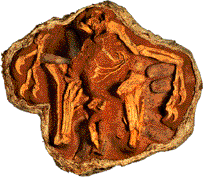
Due to the need to procreate, the trace fossil record of dinosaurs has left us two pieces of information, the egg and the nest. The structure, the nest, and the product of reproduction, the egg, have both been found on land much like those of birds or reptiles who also lay eggs. Since there are different types of shells; a soft membrane shell, a flexible shell, and a rigid shell, the only shell that would really be preserved in the fossil record is the rigid shell. The reason behind this is overburden after burial; only a rigid shell would be able to sustain a relatively decent shape or even have its shelly material preserved. The eggs of dinosaurs can be found with the embryo still intact; however the shell which is considered to be a trace fossil whereas the embryo is considered to be a body fossil.
The nest may contain shell fragments from previous
hatchlings or a series of eggs which mark a single lay, also known as a
clutch. A clutch normally has the eggs arranged in a ring. Shells
are commonly found in pieces or in the shape of a spheroid, either oblate
or semi spherical.